Monday, May 28, 2007
Gardening sign: When oak trees leaf out
& Rejecting my allotment - sigh
When the leaves of the oak have fully uncurled, plant tender annuals such as tomatoes and dahlias.
I had a chance to be the proud tender of a 20 by 30 allotment (in addition to my gardens). With this, I probably could have grown almost all of our family's produce but what with my in-laws and family coming for the entire summer and two small children, I chickened out...
For next year, the allotment president put me at the top of the list!
What is an allotment?
Don't have 'allot' of garden at your place? Perhaps you are an apartment dweller or the backyard is a dream for shady swamp plants? What you need is a plot of land close by that you can tend instead.
Where can I find me one of those?
In Ottawa, look under Community Gardens to find one near you.
I had a chance to be the proud tender of a 20 by 30 allotment (in addition to my gardens). With this, I probably could have grown almost all of our family's produce but what with my in-laws and family coming for the entire summer and two small children, I chickened out...
For next year, the allotment president put me at the top of the list!
What is an allotment?
Don't have 'allot' of garden at your place? Perhaps you are an apartment dweller or the backyard is a dream for shady swamp plants? What you need is a plot of land close by that you can tend instead.
Where can I find me one of those?
In Ottawa, look under Community Gardens to find one near you.
Sunday, May 27, 2007
Season show stoppers
Green Thumb Sunday

Regular chives
If you want a glorious Ottawa garden in late May, these were the stars that stole the show in my neighbourhood gardens:
Nursery Regulars:
Ground Phlox
Lilac
Stonecrop
Tulip
Ajuga
Columbine (non native)
Giant Alliums
Dwarf Iris
Native (what a month for them!)
Bleeding Heart
Solomon's Seal
Foam Flower
Trillium
Columbine (native)
Tall Phlox
Bunch Berry
Violets
Ferns uncurling
Anenome
Vegetables (based on my garden)
-- the greens have it --
Rocket
Mache
Early Leaf Lettuce (the heading is just getting going for me)
Spinach
Broccoli Rabe
Chives
Turnip greens
Beet thinnings
Rhubarb
In the works:
Bearded Iris, who has been waiting impatiently in the wings, is just putting on her costume, so are oriental poppy, jacob's ladder, peony and dianthus (pinks). I even saw a flower on my rugosa.
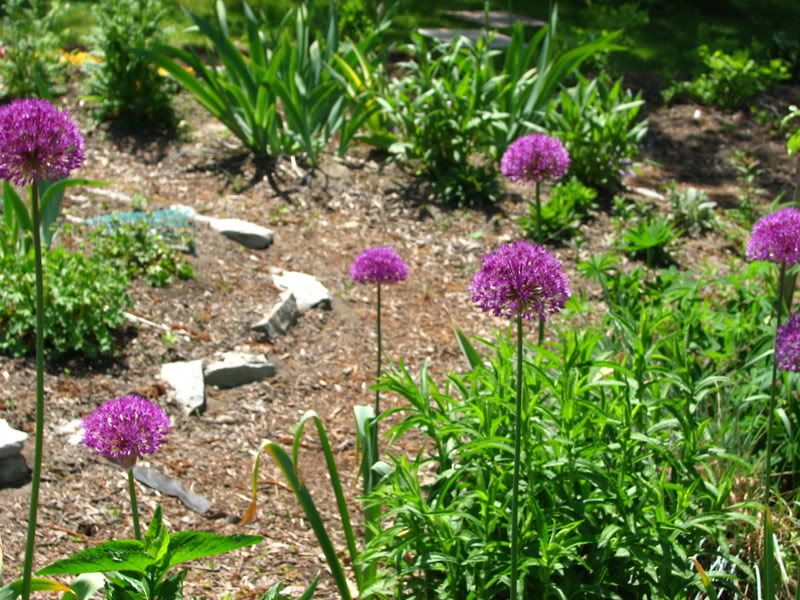
Giant Alliums

Join
Gardeners, Plant and Nature lovers can join in every Sunday, visit As the Garden Grows for more information.
Labels:
bulbs,
green thumb sunday,
herb,
season show stoppers,
vegetable
Wednesday, May 23, 2007
Psst - Native Plant Sale, this saturday
So I don't really want to tell you that there is a native plant sale this Saturday, June 2nd, starting at 9.30 at the Fletcher Wildlife Garden. It's just that I feel I have to.
Now you know - save me some plants!
Oh, and since I'm at it, there is also a community yard and plant sale right in Carlington. Here are the details (arm twisted):
Links:
Fletcher Wildlife Garden
Carlington Community Association
Now you know - save me some plants!
Oh, and since I'm at it, there is also a community yard and plant sale right in Carlington. Here are the details (arm twisted):
Carlington Community Yard & Plant SaleSaturday, June 2, 20078 a.m. - 2
p.m.Rain date: Sunday June 3(Carling/Merivale/Kirkwood Avenue Area)Sponsored by Carlington Community Association (CCA)
Links:
Fletcher Wildlife Garden
Carlington Community Association
Tuesday, May 22, 2007
Frost Watch 2007 - Day 8
Peppers are frost tolerant?

Crabapple, Pretty plant interlude
It seems that the frost watch is nearing its end. We are heading into a mini heat wave, though there may be a few more dips in temperature, we should be leaving 4C and under behind.
All plants survived... (so far)
So to round it all up, a question... my big book of plants says peppers, even capsicum annum (the common garden pepper, including most hot kinds and all sweet kinds) are frost tolerant.
Heads turned on that one, didn't they?
So I endeavor to find out the truth. I figure they ain't that frost hardy! But exactly how hardy are they? Will they stand a light frost?
The Unintentional Experiment:
You may remember my frosted tomato post. That same night, I also left out my eggplants, peppers, ground cherries and sunberries. All frost tender but differently affected. The ground cherries seemed unphased. The peppers appeared wilted in the morning but recovered completely by midday - no obvious damage to the leaves at all. I can't remember what happened to the sunberries though they seem to have no leaf damage either. They may have been very immature at the time. The tomatoes initially seemed fine, but as the day progressed, brown marks appeared between the leaf viens, eventually these lower leaves fell off and new ones grew at the leaf axis.
Does this mean that peppers are marginally (like 1 or 2 degrees) more frost tolerant? Does this mean that ground cherries are husky northern cousins in comparison?
Googling peppers and frost tolerance
According to Plants of a Future database:
"Plants can tolerate a small amount of frost[171]"
My favourite source for plant info - Floridata - agrees, stating:
"Mature plants can tolerate a touch of frost."
That's all the evidence I need, for now. So it seems that a mature pepper plant could take a light or patchy frost occasionally but would be happier without one. I imagine it would drop its leaves but they would soon grow back, as happens when they are stressed for other reasons such as drought, change in light level, doesn't like the look of your shirt...
Ground cherry and frost tolerance?
I have been on this google romp before and found that there are solanum (tomatoes, eggplants, potatoes, ground cherries, sunberries, garden huckleberries all belong to this group) brothers and sisters that live, even thrive, this far north. Amoung them are ground cherries. They are not necessarily the best tasting ones (though I have never sunk my teeth into them) but they exist.
Amoung the solanum relatives up north are:
1. Deadly Nightshade - not recommended eating
2. Chinese Lanterns. Anyone with them in their garden will vouch for their hardiness.
3. Clammy Ground Cherry
There are others, I'm sure, but let's focus on the 'ground cherries'. Of the many species listed, I saw a predominance of those that preferred to be in warmer climes but there are some that grow wild here. So was it a fluke that my Aunt Molly's Ground Cherry seemed unaffected by the mild frost that singed my tomatoes and scared my peppers?
I have yet to find a definitive answer, but as always I will notify you immediately when I do.
Black tomatoes more frost tolerant?
And finally, let us think on this quote from Ferme du Zephyr:
"Black tomato plants tend to be quite cold-hardy, with some degree of frost tolerance".
Really?
Anyone have any experiences?
Labels:
ground cherries,
peppers,
tomatoes,
weather
Monday, May 21, 2007
No Comments?
For some reason my blogger decided that it was tired of comments, that it needed some alone time. I however had a different opion and have changed the settinds back to allow comments!
Sunday, May 20, 2007
Trilliums
Green thumb sunday
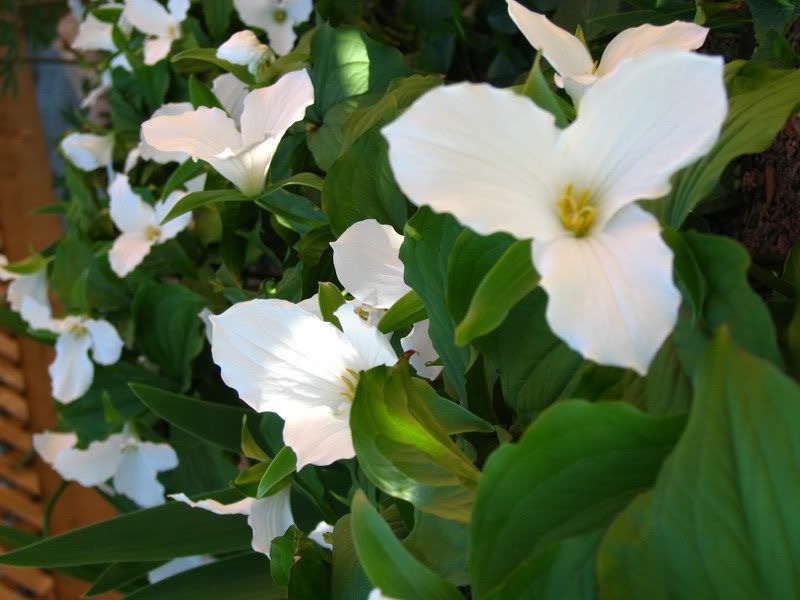
Finally in bloom. A marvel of Eastern Canada.

Join
Gardeners, Plant and Nature lovers can join in every Sunday, visit As the Garden Grows for more information.
Tulip Festival, Ottawa
Green Thumb Sunday

Tulips and crab apple blossoms
The tulip festival is held annually in our nation's capital, Ottawa. Following is a briskly written and researched journey into some things tulip (relatives visiting).
History of the Tulip Festival
100, 000 tulip bulbs were presented to Canada by Princess Juliana of the Netherlands in 1945 to thank them for providing their citizens with safe haven during WWII.
They were pretty. People came, people told others, soon a festival grew up around them.

Rainbow of tulips. The purple one is called Holland Cherry. Next time I will take notes, but I believe the orange stripey ones were Hermitage.
Tulip Festival Now
Planted in great swatches of colour, these tulips attract visitors, and their cameras, from all over the world. Here are some of their backsides.

Where are the tulips? There are tulips here right?

These pink and white tulips are called strawberry and cream - it's all in the name...
Now, it has more than just flowers, but the usual assemblage of vendors, buskers, and music. They even have a forest of wooden painted tulips.
Species Tulips
These are short, vigorous tulips that perennialize well. As the name suggests, they are genetically close to their mother plants (though may be minimally crossed) which have originated in the Middle East.
Check out this wikipedia entry for more details.
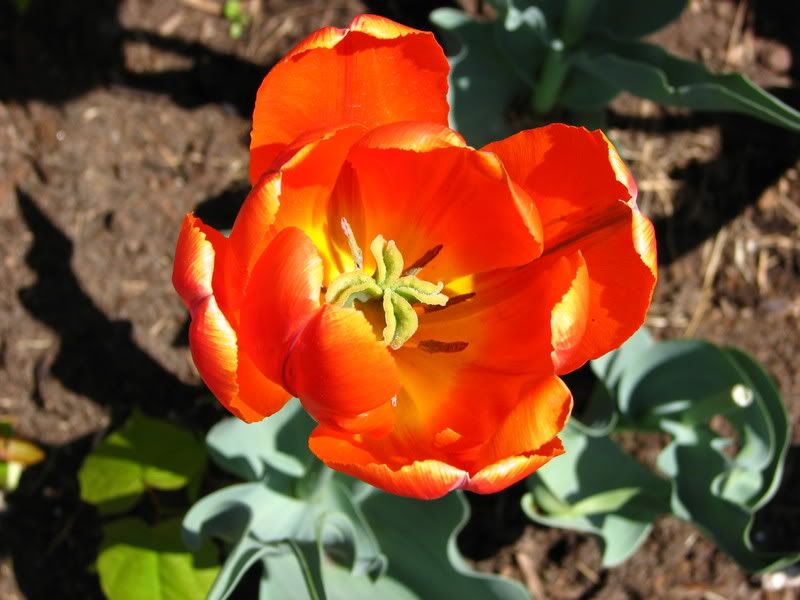
Tulip mouth
Hybrid Tulips
Most of the ones that we gardeners buy are hybridized tulips which some complain lose their vigour after a couple years. (I have some long, red stemmed tulips that were just crowded - we are talking 100s of bulbs in a 1 foot square space. When I moved them around, most grew and flowered. I presume these were hybrids but they were planted by the original owners who knows when).
How many of the original 100,000 are left I wonder? How long do tulips live?
Sadly, I can't answer these questions today, but fear not, there will be another festival, another time to write about tulips!

The white are called tres chic
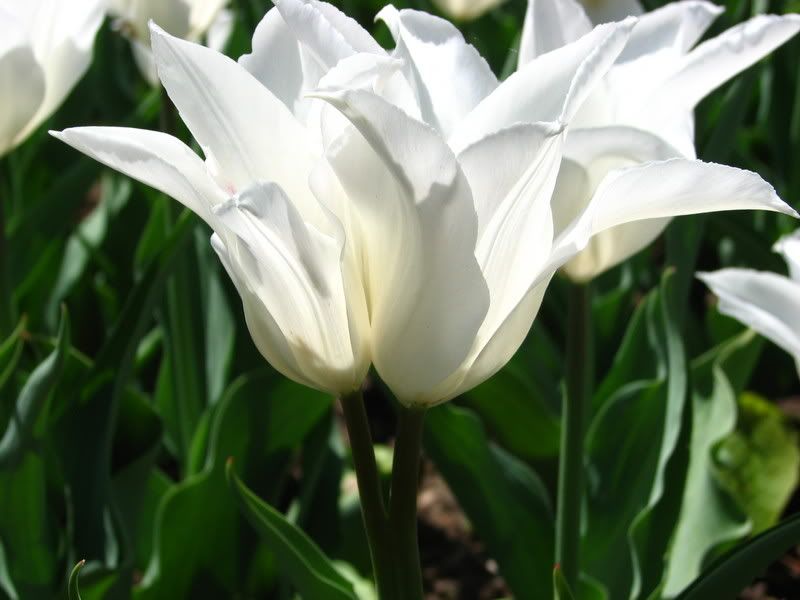
A twinned tulip.
Tulips Propogation
Members of the lily family, they can reproduce by offsets (all kinds) as well as by seed (not all).

All alone in a sea of red.
Links:
Floridata on tulips
Growing tulips from seed.
Other blog with tulip festival posts:
http://www.pagehalffull.com/humanyms/?p=987
Garden Gremlin
http://www.dalehogan.ca/blogs/tellthestory/2007/05/tulip-festival-2007.html
http://www.scotthayward.com/index.php?showimage=145
http://www.loleeplanet.com/2007/05/20/tulip-festival-in-ottawa/
Saturday, May 19, 2007
Frost Watch 2007 - Day 5
Happy little plants this morning with a low of 3C.
Quick post today, but I won't leave without your promised frost fact.
How the weather forcasters use the following terms:
risk of frost 4C
patchy frost 2C
widespread frost 0C
http://www.mvfn.ca/content/climatechange/first%20frost%202005-6.pdf
Now you know.
Another freezing link
Quick post today, but I won't leave without your promised frost fact.
How the weather forcasters use the following terms:
risk of frost 4C
patchy frost 2C
widespread frost 0C
http://www.mvfn.ca/content/climatechange/first%20frost%202005-6.pdf
Now you know.
Another freezing link
Friday, May 18, 2007
Frost Watch 2007 - Day 4

Common purple violet - Pretty Plant Interlude
So far, so good with all plants present and accounted for. The lowest temperature last night was 2C at 4am according to The Weather Network. I just happened to be up at 5am... and can confirm that there was indeed patchy frost - kudos to Enviroment Canada.
Tonight's Forecast:
Environment Canada (last night's winner) 3C with risk of frost
The Weather Network 8C
Walls o' water for cheapskates (like me)
I do try and keep my addiction to gardening as painless as possible to my sig other, including talking about it sparingly and spending only a reasonable amount of money on it.
Walls of water, for the unitiated, are plastic contraptions with two walls which you fill in between with water and put around your tender plants.
You can recreate this by making a circle of 2L pop bottles, filled 3/4 with water, and attached together with duct tape (as per this person's suggestion).
Or if you have a lot of tomatoes to protect, try this fantastic idea:
"I always thought filling 1000+ soda bottles for 150 tomato plants would be time
consuming so I just stick the bottom of a clear 55gal garbage bag over an
inverted tomato cage, let it drape to ground level and then doubled over itself
back to the top. When you put water in it(between layers)with a hose only use
5-6 gal. even though it will seem like little. Its the amount of water that
matters, not the height on the cage. After your plants outgrow the cage,poke the
bags and reuse them for garbage (that won't leak). "Found further down on DIY WOW post.
Links:
A discussion on the pros and cans of WOWs (Walls of Water).
A study about frost protection of hot caps and WOWs
Thursday, May 17, 2007
Frost Watch 2007 - Day 3, problem
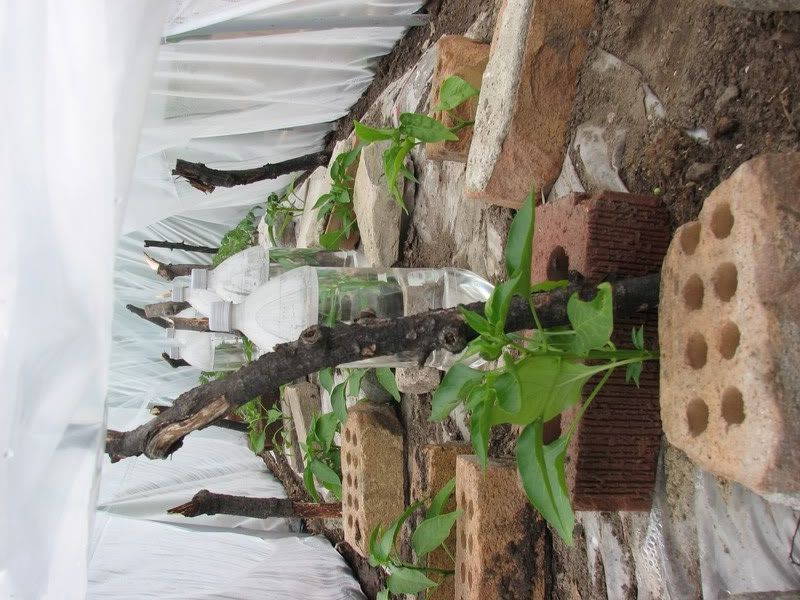
Peppers inside polytunnel * more at bottom *
Conversation with friend over for supper:
Friend: I hear there is a possibility of frost.
Me: Really?
Looking outside at cloudy sky and remembering that it is only supposed to go down to 4C
Friend: Well I heard it on the radio, maybe it's changed.
Me: Huh, be right back.
Staring at pessimistic weather report by environment Canada:
" Cloudy. 30 percent chance of showers early this evening. Clearing near midnight. Low plus 1 with patchy frost. "
Me: Thanks, I think I have to go outside for a minute.
Hubby gives me that look.
Me: I'll be right back.
Quickly, I throw winter blanket back inside of polytunnel.
Problem is that it is already clear at 10pm but 6C!
According to optimistic forcaster, the Weather Network:
Humidity 100%, Conditions Clear, low 4C.
However, the dewpoint is 1 and the humidity, currently, is 70%.
Who is right, time will tell.
And since I'm writing this, time for another frost fact:
The reason why people use water to keep crops from freezing either by using a sprinkler, wall of water or other device is not so much because the water traps heat and releases it during the night but because cooling, especially freezing water releases heat.
Same thing?
Not exactly. When you freeze water, in other words, change its state of matter, the forming of bonds causes heat to be released. This is why ice forming will warm the area nearby.
Irrigation causes the formation of ice which helps prevent crop damage.
Counterintuitive but true according to my research.
To that end, I have placed pop bottles in my polytunnel. More on that tomorrow, if the plants survive.
---
*
The ground has been pre-warmed with clear plastic mulch.
Sticks are being used to support the winter blanket I am using as a 'row cover'
Pop bottles 3/4 filled with water and bricks are being used to store heat but see above about why water is used to prevent frost.
Peppers slightly squashed because I didn't use the sticks the first night with the winter blanket.
Frost Watch 2007 - Day 3

Apple Blossoms - pretty plant interlude
I woke up early, gingerly looked out the window and noted no white glaze on the rooftops... good. But it was clear and sunny which I was not expecting. With my heart in my throat, I went outside.
It's alive! It's alive!
In fact, they all are!
The low last night according to The Weather Network was only 4 C (with a dewpoint of 0). Much higher than the forecasted 2C.
Tonight, they are predicting 4C again but I suspect that might be subject to change, hopefully upwards.
As promised, another frost fact:
Dewpoint and frost.
The dewpoint is the temperature on a given night when water will condense out of the air forming dew. At this point, relative humdity is 100%. If this dewpoint is below 0C then frost instead of dew will be formed.
A high dewpoint means that temperatures will drop more slowly, and a frost is less likely. However, a clear night with low humidity and a low dewpoint means that temperatures are able to drop much more quickly. Frost becomes more likely.
The dewpoint tonight will be 4C according to farmzone, much toastier than the -2C that it is right now.
Links:
A good explanation for grows about dewpoint and frost.
Wednesday, May 16, 2007
Frost Watch 2007 - Day 2
They survived the night under the thin pathetic plastic I provided them but it was not cold. Today, I switched to the heavy vapour barrier plastic.
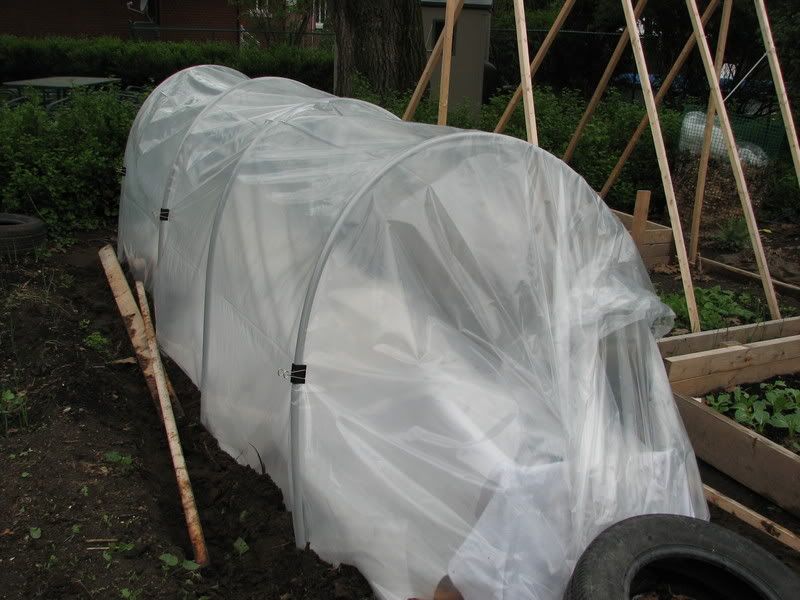
Today, a low of 2-3 C is expected with a windchill making that feel like a much more nippy -2C.
That's right my friends (and tomatoes), below 0.
A little lesson on frost:
Hortiphilia Fact
Four (degrees celcius) or less
(Frost tender) plants become a mess!
Few know (myself included until recently) that temperature is measured from about a height of 5 feet. As cold air sinks, the temperature at ground level can be much colder than that, like 0 degrees. Frost happens when the temperature is freezing - shock and surprise - so a measurement of 3 or 4 degrees, though above 0, may still mean frost for your plants.
Other factors that affect whether or not there will be a frost is how still the air is. A breeze, can keep the air circulating so that cold air doesn't have time to settle out.
4 degrees predicted? Will there be frost?
1. Cloudy weather: less chance.
2. Clear skies: more chance.
3. Rain: Less chance.
4. Snow: Draw your own conclusions.
5. Stiff breeze: Less chance.
6. Raised beds: Less chance.
7. Dry air: more chance
8. Cold air barrier: more chance
9. Moist packed soil: less chance
10. Loose (recently cultivated), dry soil: more chance
When in doubt, don't put it out.
or...
If it's in bed, cover its head.
How to protect plants
The sad truth, from my research, seems to be that most row covers / hot caps / polytunnels and the like only give about 2-4 degrees of frost protection. However, that can be quite significant if you are expecting a nightime temp of around 3 degrees. It could mean the difference between plant death and plant dismay.
You can use pretty much anything to cover plants in a pinch such as an overturned pot, cardboard box, old towel, blanket, an impromptu coldframe constructed out of hay barrels or other supports and some sort of light such as an old storm window or plastic sheeting.
You can also use more classic products such as a hot cap, or polytunnel, but apply these before dusk as much of the frost protection comes from the microclimate created inside. Heat is stored by pots, the ground etc... inside the polytunnel and then radiated back out at night.
Caution: Make sure your plants don't overheat which is easier than you may think in a polytunnel on a warm day. Raise the sides, open the ends, otherwise ventilate.
Floating row cover is also an option but again it only gives you a couple of degrees of frost protection. It will be more affective if it doesn't actually touch the plants. This can be accomplished by hoops such as the polytunnel or by jabbing sticks into the ground so that the floating cover tents out above the plant. Primarily, the advantage of row covers is to provide a protected environment to speed along the growth of young plants or to keep out pests.
Stay tuned for more on whether the plants will weather the weather.
Each day they live, I will find another exciting frost fact to post.
Links:
Great discussion on frost - aimed at strawberry growers but very useful to all.
Discussion on polytunnels - by a manufacturer

Today, a low of 2-3 C is expected with a windchill making that feel like a much more nippy -2C.
That's right my friends (and tomatoes), below 0.
A little lesson on frost:
Hortiphilia Fact
Four (degrees celcius) or less
(Frost tender) plants become a mess!
Few know (myself included until recently) that temperature is measured from about a height of 5 feet. As cold air sinks, the temperature at ground level can be much colder than that, like 0 degrees. Frost happens when the temperature is freezing - shock and surprise - so a measurement of 3 or 4 degrees, though above 0, may still mean frost for your plants.
Other factors that affect whether or not there will be a frost is how still the air is. A breeze, can keep the air circulating so that cold air doesn't have time to settle out.
4 degrees predicted? Will there be frost?
1. Cloudy weather: less chance.
2. Clear skies: more chance.
3. Rain: Less chance.
4. Snow: Draw your own conclusions.
5. Stiff breeze: Less chance.
6. Raised beds: Less chance.
7. Dry air: more chance
8. Cold air barrier: more chance
9. Moist packed soil: less chance
10. Loose (recently cultivated), dry soil: more chance
When in doubt, don't put it out.
or...
If it's in bed, cover its head.
How to protect plants
The sad truth, from my research, seems to be that most row covers / hot caps / polytunnels and the like only give about 2-4 degrees of frost protection. However, that can be quite significant if you are expecting a nightime temp of around 3 degrees. It could mean the difference between plant death and plant dismay.
You can use pretty much anything to cover plants in a pinch such as an overturned pot, cardboard box, old towel, blanket, an impromptu coldframe constructed out of hay barrels or other supports and some sort of light such as an old storm window or plastic sheeting.
You can also use more classic products such as a hot cap, or polytunnel, but apply these before dusk as much of the frost protection comes from the microclimate created inside. Heat is stored by pots, the ground etc... inside the polytunnel and then radiated back out at night.
Caution: Make sure your plants don't overheat which is easier than you may think in a polytunnel on a warm day. Raise the sides, open the ends, otherwise ventilate.
Floating row cover is also an option but again it only gives you a couple of degrees of frost protection. It will be more affective if it doesn't actually touch the plants. This can be accomplished by hoops such as the polytunnel or by jabbing sticks into the ground so that the floating cover tents out above the plant. Primarily, the advantage of row covers is to provide a protected environment to speed along the growth of young plants or to keep out pests.
Stay tuned for more on whether the plants will weather the weather.
Each day they live, I will find another exciting frost fact to post.
Links:
Great discussion on frost - aimed at strawberry growers but very useful to all.
Discussion on polytunnels - by a manufacturer
Tuesday, May 15, 2007
Frost Watch 2007 - Day 1

Bleeding heart - pretty picture interlude.
I hastily covered my row with a winter blanket. It got soggy in the rain and squashed the plants.
They recovered.
Tonight, the optimistic forecaster - the Weather Network - is calling for a low of 12C. The less optimistic one - Environment Canada - thinks 6C. I think the difference is in who is predicting for a clear night and who thinks rain.
I've covered the bed with some foamy packaging material, and the polytunnel support with some light weight plastic, weighted down with soil. Tomorrow I have to get the real heavy duty stuff. I will also be adding a second layer of protection.
Stay tuned. I'll post pictures.
Monday, May 14, 2007
Frost Watch 2007, poor tomatoes
The weather is cruel this year. The 'average' last frost in Ottawa is May 6th. But this year, the longterm forcast has been threatening frost on and off every other day for weeks. My babies are WAY overgrown again! Next year, I'm not starting anything until April.
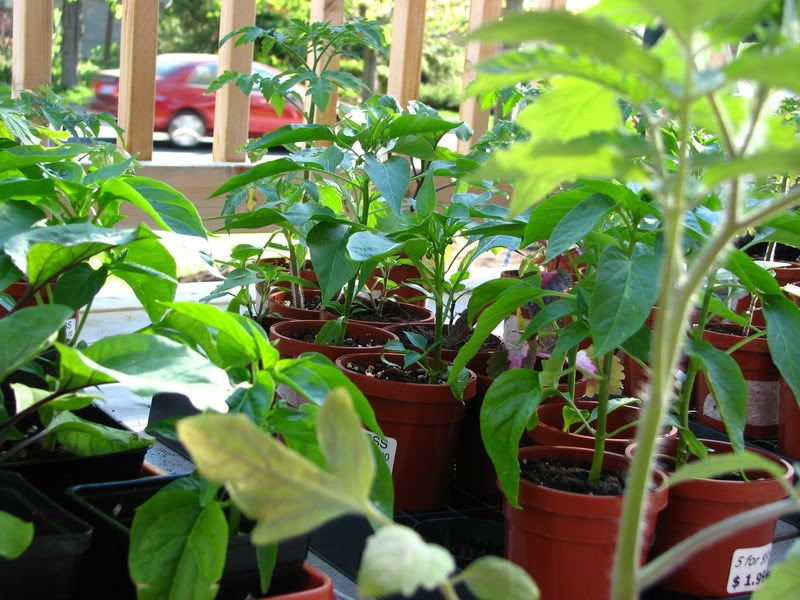
Overgrown seedlings - mostly solanums such as tomatoes, peppers, eggplants.
Even the traditional planting date of the may long weekend may err this year, with a possible frost called for on May 23rd.
However, as it often is with longterm forcasts, as we approach the appending doom day, things become more moderated though still not at the average minimums which normally would have allowed me to put out my tomatoes at this point.
I say, I have had enough! That's it! I am planting them darn it!
They may die.
But I am going to give them a fighting chance.
1. Warm the soil with a plastic mulch.
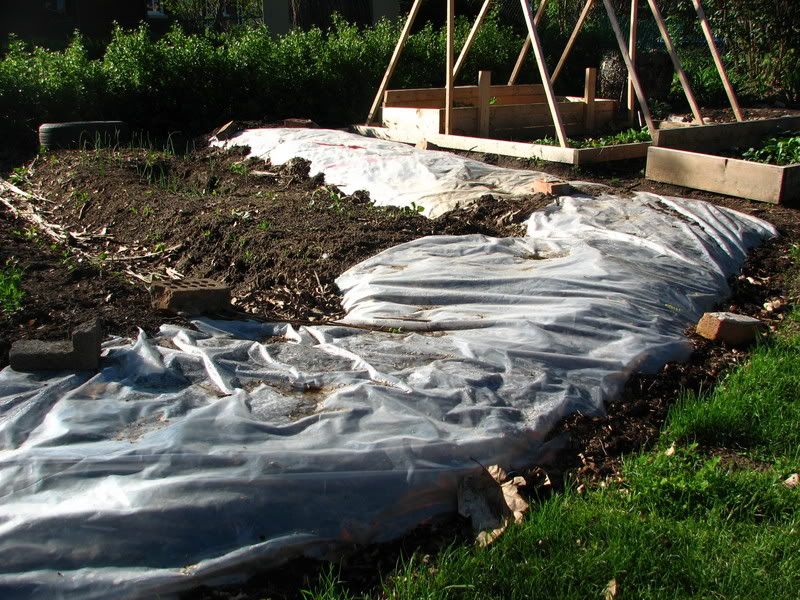
2. Add polytunnel frame with rebar and pvc piping.

Stab ground with rebar, thread pvc tubing overtop, or use other metal, other flexible plastic, fiberglass ribs or even tree branches to make the ribs.
3. Cut X's in plastic mulch, plant unsuspecting plants deep, cover holes with sand.

Scissors work well. (I did try just stabbing them with my pruning shears but it was more effort than what was required to go upstairs and fetch my scissors).

Poor little eggplant...
4. Water well. Line with bricks to trap warmth.

They look so healthy and alive here...
5. Cover polytunnel with more plastic, slits cut in top to let out some hot air and let in water. Clip on with binder clips.
--Picture is coming--
6. Wait and watch.
I will keep you updated as to whether they all fall prey to FROST.
Links:
Clear plastic mulch for soil solarization - steralizing the soil
Gotta check out this: Jack Frost Foam

Overgrown seedlings - mostly solanums such as tomatoes, peppers, eggplants.
Even the traditional planting date of the may long weekend may err this year, with a possible frost called for on May 23rd.
However, as it often is with longterm forcasts, as we approach the appending doom day, things become more moderated though still not at the average minimums which normally would have allowed me to put out my tomatoes at this point.
I say, I have had enough! That's it! I am planting them darn it!
They may die.
But I am going to give them a fighting chance.
1. Warm the soil with a plastic mulch.

2. Add polytunnel frame with rebar and pvc piping.

Stab ground with rebar, thread pvc tubing overtop, or use other metal, other flexible plastic, fiberglass ribs or even tree branches to make the ribs.
3. Cut X's in plastic mulch, plant unsuspecting plants deep, cover holes with sand.

Scissors work well. (I did try just stabbing them with my pruning shears but it was more effort than what was required to go upstairs and fetch my scissors).

Poor little eggplant...
4. Water well. Line with bricks to trap warmth.

They look so healthy and alive here...
5. Cover polytunnel with more plastic, slits cut in top to let out some hot air and let in water. Clip on with binder clips.
--Picture is coming--
6. Wait and watch.
I will keep you updated as to whether they all fall prey to FROST.
Links:
Clear plastic mulch for soil solarization - steralizing the soil
Gotta check out this: Jack Frost Foam
Sunday, May 13, 2007
Perennial of the yea(s)
Green Thumb Sunday
There could only be one winner in the perennial of the year(s). Showy, yellow double blossoms are held high above its deeply serrated green leaves. These long standing flowers are produced in a profusion which lasts from early spring to last frost, followed by a decorative seedhead. Perfect for the cottage garden, it happily self seeds. Catch those seedlings quick if you don't want more, (but why wouldn't you?) because this plant has a deep tap root that not only aerates the soil but also allows it to withstand drought. Easy to grow, it is not picky about soil, being equally happy in the traditional border or rock garden.
In our test gardens, we have also found it quite effective as a groundcover. Its broad leaves that will grow closely together excluding light from other less desirable species. It will withstand some foot traffic and may be mowed to keep low. If you prefer, it can also be naturalized in your lawn or added to the wildflower mix. Bees love it! Not only that, but it is edible! From dappled shade to full sun, this perennial is a winner. Why not add it to your gardening scheme?
Or have you already learned the delights of Taraxacum officinale:

Copied with permission from the Creative Commons archive. Credit to SierraDelta74
The dandelion

Join
Gardeners, Plant and Nature lovers can join in every Sunday, visit As the Garden Grows for more information.
In our test gardens, we have also found it quite effective as a groundcover. Its broad leaves that will grow closely together excluding light from other less desirable species. It will withstand some foot traffic and may be mowed to keep low. If you prefer, it can also be naturalized in your lawn or added to the wildflower mix. Bees love it! Not only that, but it is edible! From dappled shade to full sun, this perennial is a winner. Why not add it to your gardening scheme?
Or have you already learned the delights of Taraxacum officinale:

Copied with permission from the Creative Commons archive. Credit to SierraDelta74
The dandelion

Join
Gardeners, Plant and Nature lovers can join in every Sunday, visit As the Garden Grows for more information.
Labels:
edible weeds,
green thumb sundya,
groundcover,
perennial
Monday, May 7, 2007
Foliage - the new flower

Ornamental Sweet Potato Vine. Permission for use through Creative Commons. Photo by Tiglio Art's
In a perrenial bed, you might try to have something flowering at all times and certainly at the height of summer, it is hard not to get a display. However, at other times, you may have a solid mass of green with only a bloom here or there to break it up.
There are various strategies for coping with this including incorporating plants with strong structural shapes.
You can also look for plants with interesting and contrasting foliage. So even when there is no flower, there is still colour. Leaves don't just come in green. They can be steel-blue, grey, lime, pink, purple, peach, white, yellow, red, tan, orange, almost black and mixtures of the above.
Thankfully many classic foliage plants are also shade lovers, a place not conducive to heavy flowering:
1. hosta
2. coleus
3. coral bells

Coleus. Shared through Creative Commons. Photo by jam343
Coleus = Colour
Don't just think of Coleus blumei, otherwise known as the painted or flame nettle, as a plant that you buy from the nursery every spring to pop into your planter box. It is extremely easy to root and overwinters happily indoors. If you know someone with a coleus you envy, ask for a cutting and stick it in a glass of water. You too will have that plant before you know it. As winter approaches, either dig up the plant or take cuttings for next year.
Oh and though traditionally it is known as a shade plant (colour fading in the sun), some are supposed to be tolerant of heat. I have never tried them so I don't know and there is no shortage of plants that look great in full sun.
Hortiphilia Fact:
Coleus is a 'tender perennial' BUT if it sets seeds, it soon expires.
How sweet is the Sweet Potato Vine
If the spot you need to jazz up is sunnier, you'll be happy to hear that the purple colour in plants is their version of a tan so it deepens in the sun. Many, many plants have darker versions, but the one I would like to focus on is the sweet potato vine, otherwise known as Impomoea batatas
It comes in a host of colours from chatruese to cerise to bruise purple. The local nursery has an agricultural sized table of varieties. And like the coleus, sweet potato vine can be 'easily' rooted from cutting and overwintered.
That's what I might try and do with this little surprise.
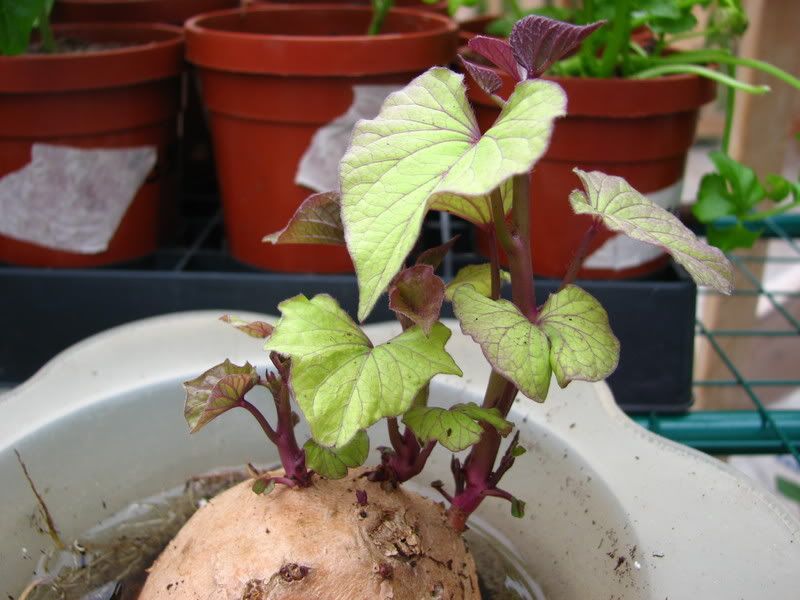
Sweet potato sprouts
I noticed some sprouts on my sweet potato so decided to let it grow, figuring that it would be some dull shade of the aforementioned standard 'cholorphyll' green when what before my wondering eyes did appear but variated purple and lime green. So perhaps it's just this colour because it's stressed and maybe it will revert to regular green later, but maybe not!
Links:
All about coleus by wikipedia
overwintering and propogating ornamental sweet potato vine by tuber
Annual or Perennial? That is the question
Grow a Coleus Standard - wild!
Subscribe to:
Posts (Atom)
